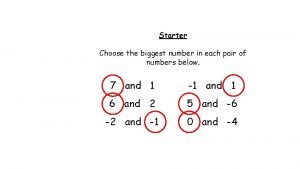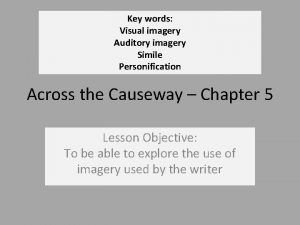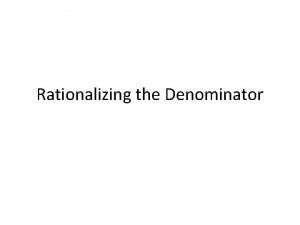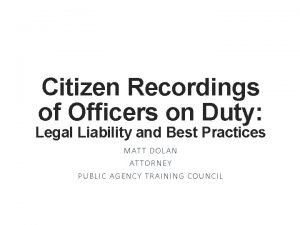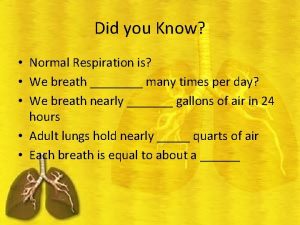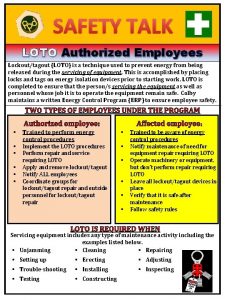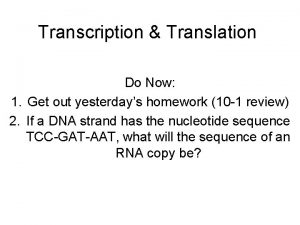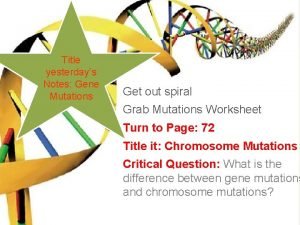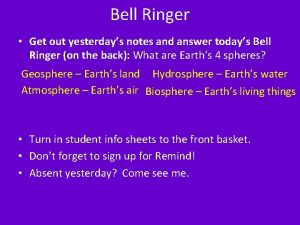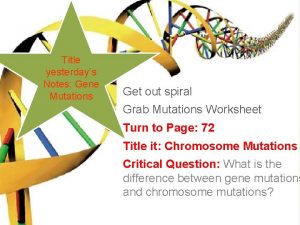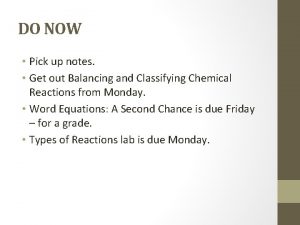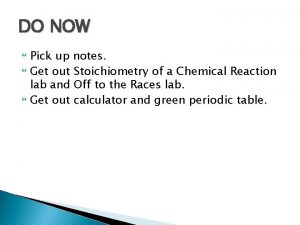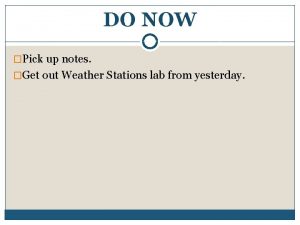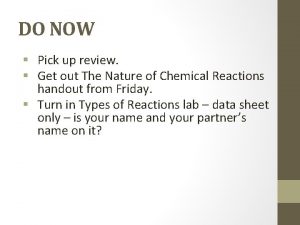DO NOW Pick up notes Get out yesterdays






































- Slides: 38

DO NOW Pick up notes. Get out yesterday’s notes. Turn in “Turn up the Heat” if you did not do so yesterday.

KINETIC-MOLECULAR THEORY 1. 2. 3. 4. 5. State three parts o the Kinetic. Molecular Theory. How are temperature and heat different? If temperature increases, what happens to the energy of the particles? Define absolute zero. What temperature is absolute zero? _____ K and ______ °C

KINETIC-MOLECULAR THEORY Convert the following temperatures using the formula K = °C + 273. a. 247 K = _____ °C d. ______ K b. 628 K = _____ °C e. ______ K c. 125 K = _____ °C f. ______ K -173°C = 107°C = 273°C =

PHASES OF MATTER � The phase of matter is determined by two things: 1. Temperature (kinetic energy) of the particles. 2. Intermolecular Force of Attraction (IMFs) – these are the forces between molecules. a. Dispersion forces b. Dipole-dipole forces c. Hydrogen bonds

PHASES OF MATTER All INTERmolecular forces are weaker than INTRAmolecular forces which are true bonds (ionic, covalent, metallic).

PHASES OF MATTER Characteristics of the Phases of Matter SOLID definite rigid shape, definite volume, strong IMF, particles are in a fixed position, and vibrate around a fixed point.

PHASES OF MATTER Characteristics of the Phases of Matter LIQUID no definite shape, definite volume, strong IMF, particles can flow past each other but cannot break away completely.

PHASES OF MATTER Characteristics of the Phases of Matter - GAS no definite shape, no definite volume, very weak IMF, particles are independent of each other and go wherever they want inside their container. Another word for gas is vapor.

PHASES OF MATTER Characteristics of the Phases of Matter - PLASMA no definite shape, no definite volume, composed of electrons and positive ions. The electrons have been knocked away from the atoms due to the high temperatures. Most common state of matter in the universe.

DRAWING MATTER Looking at the boxes below and pretend that they are beakers sitting on a counter. Show what the atoms of a solid, liquid, and gas would look like in each. SOLID LIQUID GAS

ACTUALLY SIX PHASES OF MATTER Solid Liquid Gas Plasma Bose-Einstein Condensate Fermionic Condensate

BOSE-EINSTEIN CONDENSATE A Bose–Einstein condensate (BEC) is a state of matter of a dilute gas of bosons cooled to temperatures very close to absolute zero.

FERMIONIC CONDENSATE A fermionic condensate is a superfluid phase formed by fermionic particles at low temperatures.

INTERMOLECULAR FORCES Dispersion Forces – weakest Dipole-Dipole Forces Hydrogen Bonding - strongest

DISPERSION FORCES a weak force that results in the attraction of normally non-polar particles; the weakest intermolecular force; when nonpolar molecules collide with each other, a temporary dipole is created; The more electrons in the electron cloud, the stronger the dispersion force. Examples: H 2, Cl 2, I 2

DIPOLE-DIPOLE FORCES • attractions between oppositely charged regions of polar molecules; • polar molecules have permanent dipoles due to the fact that some regions are always positive and some regions are always negative; • these forces are stronger than dispersion forces if looking at particles of the same mass. • Examples: HCl, SO 2

HYDROGEN BONDING § A special dipole-dipole attraction; § occurs when the molecule contains hydrogen and the hydrogen is covalently bonded to a highly electronegative atom (only F, O, N); § The molecule is highly polar; § Molecules have higher than expected boiling points (strong IMF). § Examples: water, H 2 O, ammonia, NH 3

INTERMOLECULAR FORCES Strongest – Hydrogen bonding Weakest – dispersion forces Permanent Dipoles: Dipole-dipole, hydrogen bonding Temporary dipole: dispersion forces

THREE PHASES Syringes of: Georgia red clay Water Air

MORE ON SOLIDS Why is a Solid?

MORE ON SOLIDS Density – more closely packed than a liquid, thus they are denser; Usually a 10% difference between the solid and liquid density of the same substance; Water is the exception. Compression – not easily compressed.

MORE ON SOLIDS Amorphous solids – a solid where the particles are not arranged in a crystalline pattern; often forms when a molten (melted solid) cools too quickly to allow time for the crystals to grow; examples include glass, rubber, and many plastics.

MORE ON SOLIDS Thermal Expansion – most solids experience thermal expansion. Thermal Expansion is when objects are heated, they expand. When they are cooled, they contract. Example: joints in bridges, driveways, and roads.

MORE ON LIQUIDS Density – denser than gases. Compression – enormous pressure can make liquids compress a small amount.

MORE ON LIQUIDS Fluidity – ability to flow; gases and liquids are fluids because they can flow through each other. Liquids are slower to diffuse than gases. Diffusion is the spreading of particles throughout a given volume until they are evenly distributed.

MORE ON LIQUIDS Viscosity Viscosit y Derby – a measure of the resistance of a liquid to flow; determined by the intermolecular forces, shape of particles, and temperature.

MORE ON LIQUIDS Thermal Expansion – liquids experience more thermal expansion than solids. Example: thermometers

MORE ON LIQUIDS Surface tension – the energy required to increase the surface area of a liquid by a given amount; It is a measure of the inward pull by particles in the interior; The stronger the particle’s attraction for each other, the stronger the surface tension; Water has a high surface tension due to the attractive forces of the water molecules; Surfactants reduce surface tension.

SURFACE TENSION

SURFACE TENSION

MERCURY BEAD

WATER BEAD

MORE ON LIQUIDS Capillary Action – the adhesion or attraction between molecules that are different; Can cause the meniscus in the graduated cylinder or the wicking property of paper towels. Cohesion = attraction to each other. Adhesion = attraction to another.

CAPILLARY ACTION ADHESI ON WATE COHESIO N MERCURY

CAPILLARY ACTION

MORE ON GASES Density – very low density. Compression – gases are easy to compress. There a lot of spaces between the particles.

MORE ON GASES Fluidity – ability to flow; gases and liquids are fluids because they can flow through each other. Gases diffuse faster than liquids. Thermal Expansion – gases experience more thermal expansion than solids and liquids. Example: hot air balloons

TO DO Do Review and Reinforcement: States of Matter – due Monday.
 Shot me out of the sky you're my kryptonite
Shot me out of the sky you're my kryptonite Get on get in get off
Get on get in get off What are pick up notes
What are pick up notes Food chain of rabbit
Food chain of rabbit 4 x 7
4 x 7 Imagery simile
Imagery simile Aakash saw his sister's son
Aakash saw his sister's son Now i see it now you don't
Now i see it now you don't Hooray cheered gilda. does that mean we can stay?
Hooray cheered gilda. does that mean we can stay? Somebody once asked could i spare some change for gas
Somebody once asked could i spare some change for gas Confirm your email now and get 5 minutes as a gift!
Confirm your email now and get 5 minutes as a gift! Get up get moving quiz
Get up get moving quiz Get up get moving quiz
Get up get moving quiz Get up get moving
Get up get moving Sequence pseudocode
Sequence pseudocode Get focused get results
Get focused get results Get up get moving quiz
Get up get moving quiz Act out the conversation
Act out the conversation The rugged cross my salvation
The rugged cross my salvation How to get a radical out of the denominator
How to get a radical out of the denominator Get out of jail free card
Get out of jail free card Get out of my school
Get out of my school How quickly did things get out of hand in salem
How quickly did things get out of hand in salem Get the word out we back up
Get the word out we back up Do words have power
Do words have power The second foundation get out of debt
The second foundation get out of debt Bart simpson tin foil hat
Bart simpson tin foil hat A piece get out of paper
A piece get out of paper Knocking the wind out
Knocking the wind out Wisc
Wisc Put out the light and then put out the light
Put out the light and then put out the light Meaning of out out by robert frost
Meaning of out out by robert frost Out of sight out of mind quote
Out of sight out of mind quote Out out- analysis
Out out- analysis Loto safety talk
Loto safety talk Out out robert frost analysis
Out out robert frost analysis Lily gulledge
Lily gulledge Matthew 11 vs 28 msg
Matthew 11 vs 28 msg Loto
Loto




